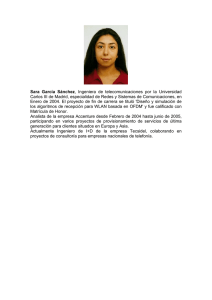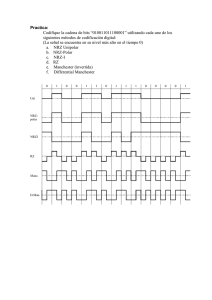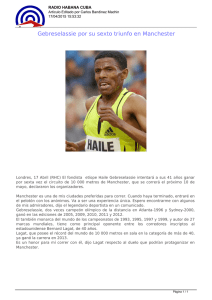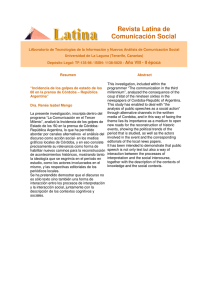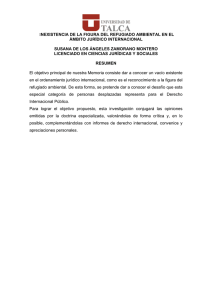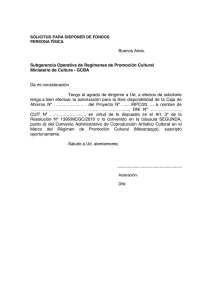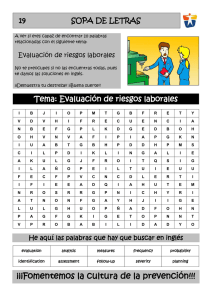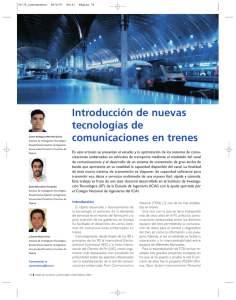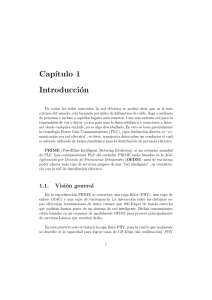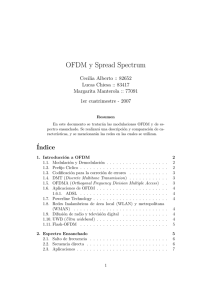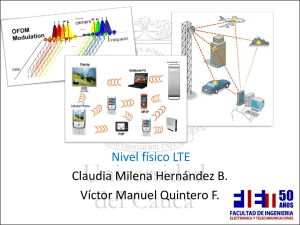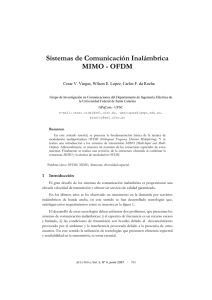abstract The Train Communication Network(TCN) that is defined in
Anuncio
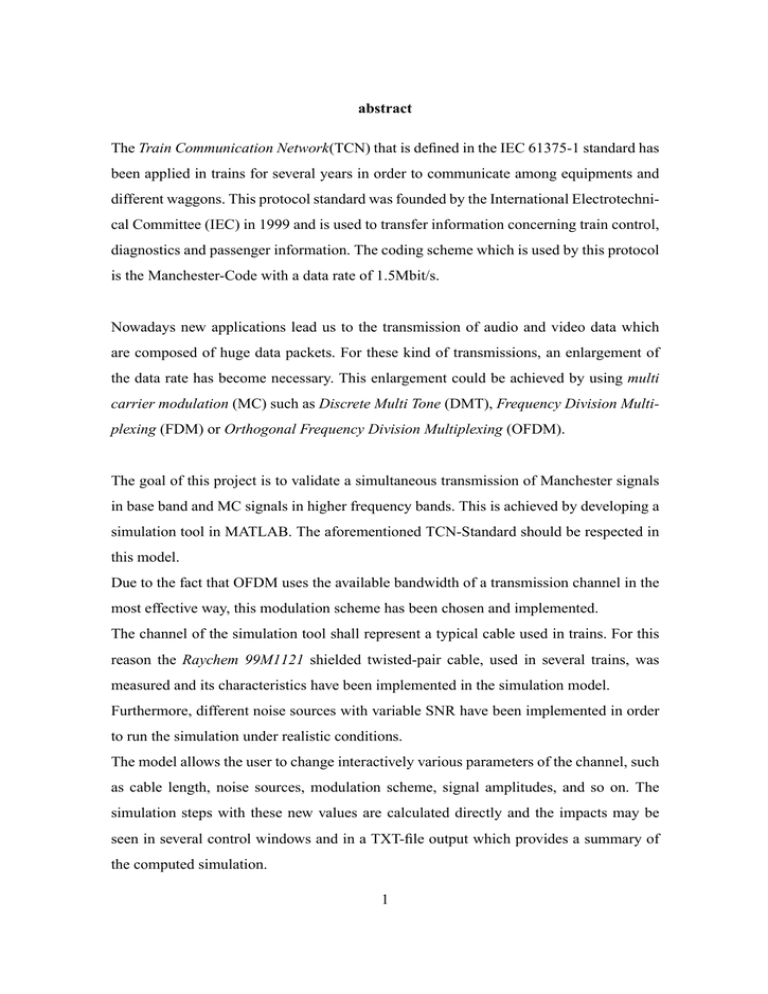
abstract The Train Communication Network(TCN) that is defined in the IEC 61375-1 standard has been applied in trains for several years in order to communicate among equipments and different waggons. This protocol standard was founded by the International Electrotechnical Committee (IEC) in 1999 and is used to transfer information concerning train control, diagnostics and passenger information. The coding scheme which is used by this protocol is the Manchester-Code with a data rate of 1.5Mbit/s. Nowadays new applications lead us to the transmission of audio and video data which are composed of huge data packets. For these kind of transmissions, an enlargement of the data rate has become necessary. This enlargement could be achieved by using multi carrier modulation (MC) such as Discrete Multi Tone (DMT), Frequency Division Multiplexing (FDM) or Orthogonal Frequency Division Multiplexing (OFDM). The goal of this project is to validate a simultaneous transmission of Manchester signals in base band and MC signals in higher frequency bands. This is achieved by developing a simulation tool in MATLAB. The aforementioned TCN-Standard should be respected in this model. Due to the fact that OFDM uses the available bandwidth of a transmission channel in the most effective way, this modulation scheme has been chosen and implemented. The channel of the simulation tool shall represent a typical cable used in trains. For this reason the Raychem 99M1121 shielded twisted-pair cable, used in several trains, was measured and its characteristics have been implemented in the simulation model. Furthermore, different noise sources with variable SNR have been implemented in order to run the simulation under realistic conditions. The model allows the user to change interactively various parameters of the channel, such as cable length, noise sources, modulation scheme, signal amplitudes, and so on. The simulation steps with these new values are calculated directly and the impacts may be seen in several control windows and in a TXT-file output which provides a summary of the computed simulation. 1 An enlargement of the data rate of the aforementioned channel, has been achieved by using a OFDM/Frequency Division Duplexing (FDD) system with two frequency bands of approximately 2.2M Hz. The upstream band is centered at the carrier frequency of 5MHz and the downstream band is centered at the carrier frequency of 9MHz. Manchester signals are transmitted in baseband as required by the TCN-Standard. Depending on the modulation scheme of the OFDM signals, wether is 4 or 16 QAM, an overall data rate of 7.5M bit/s or 13.5M bit/s may be achieved. This work is concerned with the physical layer and the data link layer of the Open Systems Interconnection (OSI) Model. The physical layer treats the transmission of a raw bit stream over a cable and defines different techniques to do so. For this purpose, the Manchester code and OFDM are explained in this report and implemented. Besides, error detection and correction methods are defined in the data link layer and applied to TCN frames in the proposed model. 2 resumen La especificación TCN Train Communication Network se ha venido utilizando desde hace años con el propósito de comunicar los distintos equipos de los vagones de un tren. Este protocolo emplea una modulación conocida como Manchester-Code, que tiene una tasa de bit de 1.5Mbit/s. En la actualidad las nuevas herramientas multimedia dan lugar a transmisiones de audio y vídeo con gran cantidad de datos. Para este tipo de transmisiones convendría incrementar la tasa de bit. Este incremento podría obtenerse mediante una modulación de multiportadores (multi carrier modulation o MC), como el Discrete Multi Tone (DMT), Frequency Division Multiplexing (FDM), Orthogonal Frequency Division Multiplexing (OFDM). El objetivo principal de este proyecto consiste en validar la transmisión simultánea de las señales Manchester en banda base y las señales MC en bandas de frecuencia más altas. Esto ha sido alcanzado mediante el desarollo de una herramienta de simulación en MATLAB basada en el protocolo TCN. El OFDM utiliza el ancho de banda disponible en el medio de transmisión de la manera más eficiente, razón por la cual se ha elegido e implementado este esquema de modulación. El modelo del canal de simulación debería representar un cable típico utilizado en los trenes. Por esta razón, el cable de par trenzado Raychem 99M1121 fue medido y sus caracteristicas de ganancia y fase implementadas en el modelo propuesto. Varios modelos de ruido con valores variables para la relación señal-ruido (SNR) fueron desarollados e implementados para obtener un modelo que representara las condiciones reales en los trenes. Se ha creado un banco de pruebas que permite al usuario modificar los parámetros de longitud de cable, fuentes de ruido y su relación señal-ruido, así como la amplitud de las señales Manchester, entre otros. Los pasos de simulación se calculan sobre los parámetros de entrada, lo que permite al usario visualizar los efectos directamente sobre varias ventanas de control y un archivo de texto que pone a su disposición un resúmen de la 3 simulación realizada. Se ha alcanzado un incremento de la tasa de bits del canal utilizando un sistema OFDM/ Frequency Division Duplexing (FDD) con dos bandas de frecuencia de 2.2MHz. La banda de subida está centrada en 5MHz y la banda de bajada está centrada en 9MHz. Como exige el estándar TCN, las señales Manchester se transmiten en el banda base que está exigido del estándar TCN. Dependiendo del esquema de modulación de las señales OFDM, 4 ó 16 QAM, podemos alcanzar una tasa de bit total de 7.5Mbit/s o 13.5Mbit/s, respectivamente. Este proyecto abarca la capa fisica y la capa de enlace del modelo Open Systems Interconnection (OSI) con modulación en Manchester/OFDM y con detección y corrección de errores en las tramas de TCN. 4
